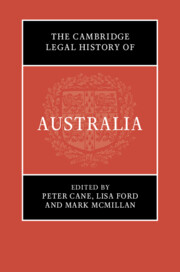Book contents
- The Cambridge Legal History of Australia
- The Cambridge Legal History of Australia
- Copyright page
- Contents
- Figures
- Maps
- Contributors
- Maps
- 1 Editors’ Introduction
- I Cultures of Law
- II Public Authority
- III Public Authorities in Encounter
- IV Land and Environment
- 13 Settlement and Dispossession
- 14 Australian Land Law
- 15 Aboriginal Land Rights, Subjection and the Law
- 16 Land Justice
- 17 Environment
- V Social Organisation
- VI Social Ordering
- VII Reckonings
- Index
16 - Land Justice
from IV - Land and Environment
Published online by Cambridge University Press: 04 August 2022
- The Cambridge Legal History of Australia
- The Cambridge Legal History of Australia
- Copyright page
- Contents
- Figures
- Maps
- Contributors
- Maps
- 1 Editors’ Introduction
- I Cultures of Law
- II Public Authority
- III Public Authorities in Encounter
- IV Land and Environment
- 13 Settlement and Dispossession
- 14 Australian Land Law
- 15 Aboriginal Land Rights, Subjection and the Law
- 16 Land Justice
- 17 Environment
- V Social Organisation
- VI Social Ordering
- VII Reckonings
- Index
Summary
Since the 1960s, Australian law has responded to the dispossession of Indigenous peoples. Most States and Territories have land rights legislation. These schemes vary, for example in their reliance on claims processes, administrative transfer and statutory vesting for returning land into Indigenous hands. In general, they confer robust property rights (often freehold) and a strong say over mining and development. The concept of native title emerged from the common law decision of the High Court in Mabo v Queensland (No 2) in 1992 and is regulated by a complex federal statute. The capacity for native title to deliver on Indigenous expectations has been influenced by court decisions in key cases, about what groups must prove in order to win recognition, what rights they obtain, what rules apply to the extinguishment of native title and what constitutes ‘just terms’ for dispossession. Governments have also affected developments, as authors of policy and legislation, and as respondents to Indigenous claims in courts and tribunals. Achieving greater land justice from native title and statutory land rights will require governments to adopt a longer-term strategic focus that emphasizes Indigenous empowerment and self-determination.
- Type
- Chapter
- Information
- The Cambridge Legal History of Australia , pp. 377 - 401Publisher: Cambridge University PressPrint publication year: 2022



